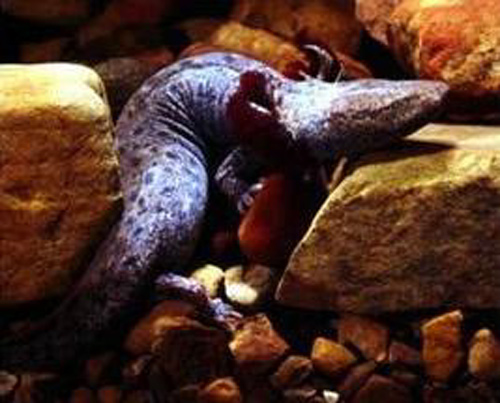Mudpuppies are permanent aquatic larvae. Common mudpuppies are smooth-skinned and gray with darker gray to black spots. They have a black stripe from the nose over the eyes to the gills. Their gills are on stalks and are large and feathery. They are the largest salamander in Connecticut and can reach 17 to 19 inches in length.
The range of the common mudpuppy is from southeastern Manitoba to southern Quebec and southwards to northern Georgia and Louisiana. They are believed to have been introduced to Connecticut and exist only in the Connecticut and Housatonic Rivers here.
Common mudpuppies can live in a variety of water qualities and inhabit rivers to drainage ditches. They grow longer gills in less oxygenated water. They are active year round and are more active in the winter. They are nocturnal.
Fishermen often pull up a mudpuppy on their hooks. They are rumored to be attracted to light.
Mudpuppies do have lungs that they can inflate and deflate. It is believed that they are used to control buoyancy rather than for breathing.
Mudpuppies mate in the fall. Eggs are laid individually under submerged rocks the next spring. A female can lay 30 to 200 eggs and guards them until they hatch in 5 weeks to 2 months.
The larvae that hatch are smaller with lighter coloring and light and dark stripes that fade with age. They will never metamorphisize into an adult stage but will remain in the aquatic larval stage for their entire lives. Females are able to breed at about 6 years of age.
Common mudpuppies eat insects, invertebrates, smaller salamanders, and small fish.
